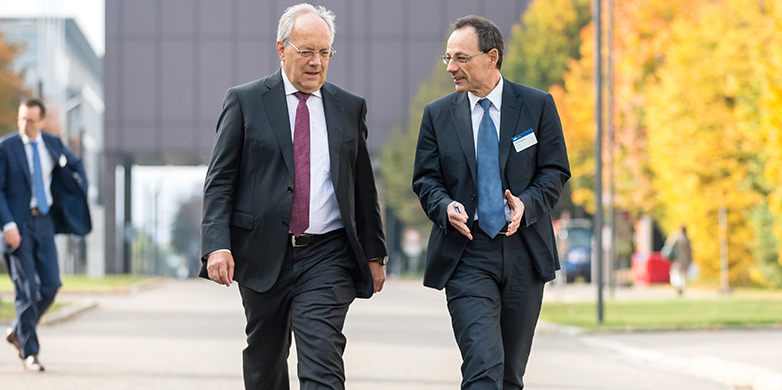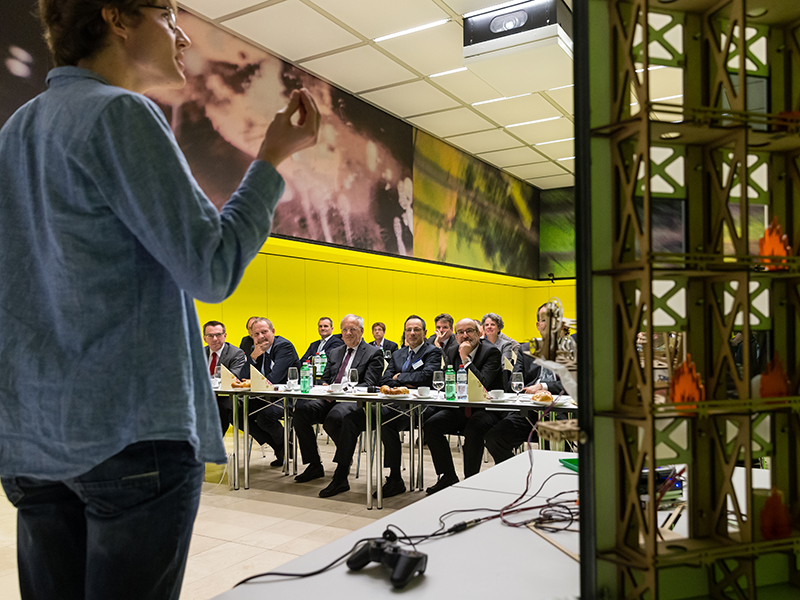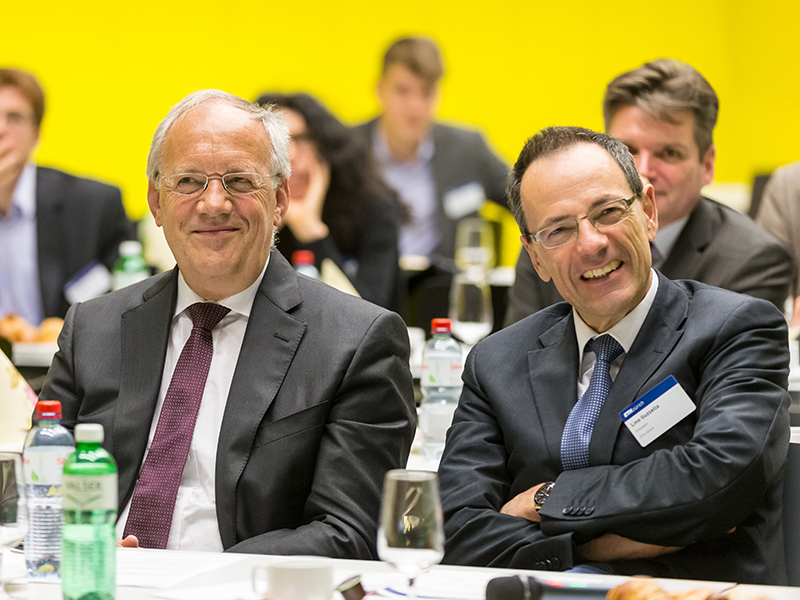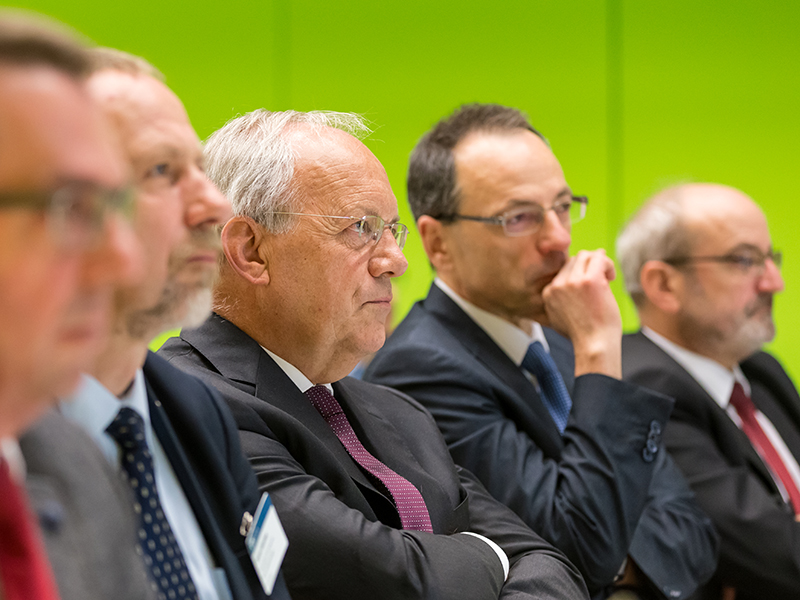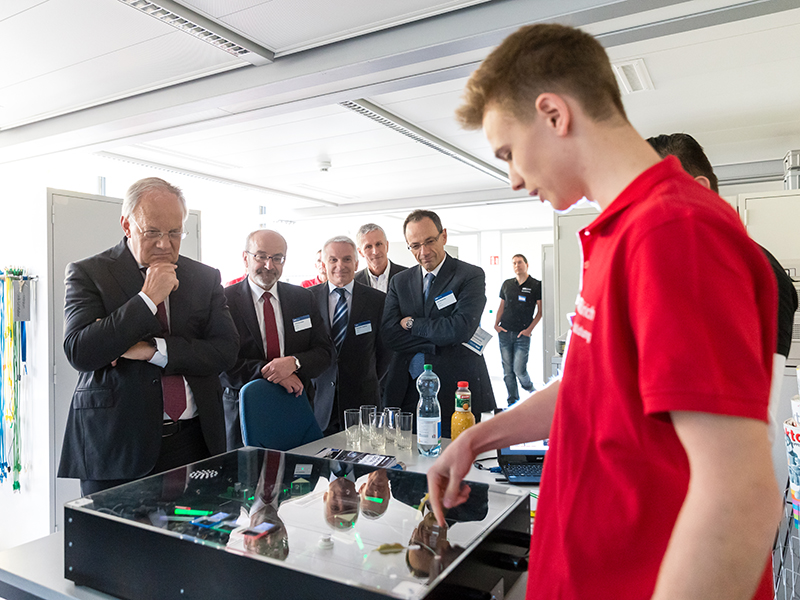Federal Councillor Schneider-Ammann is impressed by the ETH team
Johann Schneider-Ammann, Federal Councillor and head of the Department of Economic Affairs, Education and Research, visited ETH Zurich on Monday. He learned about the opportunities and challenges of digitalisation, and expressed how impressed he was by the university's achievements.
Schneider-Ammann’s visit to the Hönggerberg campus was dedicated to the digital revolution and its opportunities and challenges for the economy and industry. He noted that he is always interested in new technology, and particularly in the subject of big data, which is becoming increasingly important in his department as well. He also said that his visit could be regarded as a sign of recognition for one of the best universities in the world, of which the country can be proud. And his visit was also a return visit: almost 40 years ago, Schneider-Amman completed his studies in electrical engineering at ETH Zurich.
For ETH President Lino Guzzella, too, the visit was a sign of recognition: “For our researchers, it is very encouraging that the Federal Council is interested in and appreciates the work being done at ETH,” he said. During his welcome address, the ETH President took the opportunity to formulate a few policy wishes: he emphasised that free competition in the field of research and unrestricted access to the global talent pool are crucial to ETH’s success. He also expressed the hope for secured core funding for education and research through the federal government, as well as extensive autonomy to enable the university to develop its potential from within.
Digitalisation as an opportunity
To demonstrate this potential to the Federal Councillor, ETH put together a diverse and high calibre agenda: professors from the fields of computer science, architecture, mechanical engineering and robotics presented the technical fundamentals and use of digital technology in their respective areas. The significance of digitalisation for Zurich as a centre of research and business was elucidated by Markus Püschel, Head of the Department of Computer Science. He noted that Zurich’s location factors are unique: this explained Disney’s decision to open its only research facility outside the US and Google to build its third largest location in Zurich. Access to promising young talent was a crucial factor, he noted, with ETH playing a key role with more than 150 computer science graduates and up to five new ICT start-ups annually.
In his address, computer science professor Friedemann Mattern described the future in a cyber physical world as a world in which the gap between the physical and digital worlds narrows increasingly. Information and communication technology, said Mattern, is penetrating every aspect of our lives in the form of networked machines, products and buildings. ETH has been working on the Internet of Things for some 15 years. Mattern regards the economic and societal consequences as even more far-reaching than those we are currently experiencing with big data analytics or the use of huge volumes of unstructured data.
ETH students presented projects to the Federal Councillor conducted during their undergraduate studies using mechatronic platforms and 3D printers. Mirko Meboldt, Professor for Product Development, emphasised that as digitalisation now plays a role in everything from design and production to the finished product, it is crucial to anchor it into teaching from the outset.
Construction 4.0
Federal Councillor Schneider-Amman was visibly impressed by an ETH-developed construction robot that one day may be deployed on construction sites. Largely autonomously, the robot builds a complex, computer-designed, brick wall façade. Referring to the robot, Matthias Kohler, Professor of Architecture and Digital Fabrication, and Jonas Buchli, Professor of Agile Robotics, spoke of the impending digitalisation of the construction industry. The creative freedom of the architect will be expanded and the robot will become a type of large-scale 3D printer.
The final stop of the Federal Councillor’s tour was the ETH training laboratory. Here Schneider-Amman spoke highly of the Swiss vocational and apprenticeship system. He had just returned from the annual conference of the World Bank Group in Lima, he explained, where four Peruvian ministers had invited him to bilateral talks. All they wanted to talk about, he said, was the Swiss apprenticeship system and to learn about the Swiss model.
Fostering closer contacts with parliament
At the end of the tour, Schneider-Amman addressed the political concerns of the ETH President and expressed confidence that in spite of the forthcoming round of cost-cutting that investment in education and research would not be substantially affected. “In Bern, we have 246 members of parliament who stand behind education and research in Switzerland. They are committed to ensuring that these areas will be the last to experience any cuts.”
He was also optimistic about the prospect of a full association with the EU research programme Horizon 2020 from 2017. Due to the effect of the mass immigration initiative, until 2016 Swiss researchers are able to apply for only selected portions of the €80 billion fund. “We have many friends in Europe and we will find a solution,” he said. He referred to a talk with German Chancellor Angela Merkel that provided grounds for optimism. He also endorsed Guzzella’s call for maintenance of the autonomy of the university. Schneider-Ammann, however, put the ball back in the professors’ court: they should seek closer contact, he said, with members of parliament and actively promote the relevance of their work and the interests of ETH in parliament. This would build trust, which in turn would generate support for their autonomy.
After the three-hour visit, the presentations and talks, Schneider-Amman was impressed by the team that he had come to know at the university: “The attitude of the people here speaks to the fascination and commitment with which they conduct their work.” The ETH President was equally pleased by the visit of the head of the Department of Economic Affairs, Education and Research, and thus ultimately ETH’s boss: “We wanted to show Federal Councillor Schneider-Ammann all that ETH Zurich is doing in the field of digitalisation, and I think we have succeeded.”

